The 9-bay QNAP TVS-951X is a compact, performance-driven multimedia NAS with 10GbE connectivity. Described as a “budget-friendly” option for SMBs, the TVS-951X features the usual suspects for QNAP NAS devices; this includes three USB 3.0 ports (1 in the front and 2 on the back panel), a USB One Touch Copy button, an HDMI port, and a gigabit Ethernet port. It is also compatible with 3.5-inch, 2.5-inch hard drives, and 2.5-inch solid state drives.
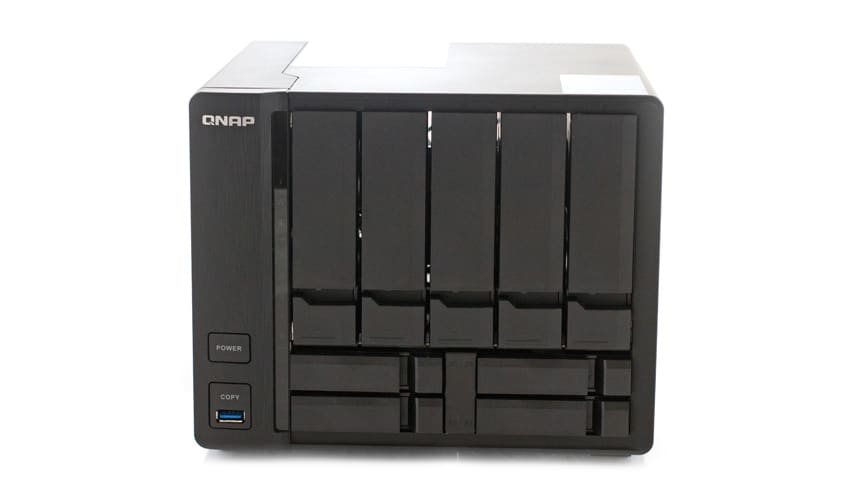
The TVS-951X is powered by a 7th-generation Intel Celeron Kaby Lake 3865U dual-core 1.8GHz processor and can be outfitted with up 32GB of DDR4 dual-channel memory. Its hybrid design features five 3.5-inch drive bays and four 2.5-inch SSD bays, the latter which allows for SSD caching and Qtier auto-tiering technologies, which automatically tiers your frequently-accessed files to the SSD to improve the overall performance of the QNAP NAS. The QNAP TVS-951X also features a built-in 10GBASE-T/NBASE-T port and AES-NI encryption. Performance-wise, the QNAP NAS is quoted to deliver up to 779MB/s read and 739MB/s write using 10GbE connectivity in a Windows environment. When transferring encrypted volumes, performance is expected to reach up to 720MB/s and 363MB/s for reads and writes, respectively.
For its multimedia applications, the QNAP NAS comes equipped with advanced Intel HD Graphics 610 and supports dual-channel 4K H.264/H.265 hardware decoding and real-time transcoding for up to 30fps at 4K using the HDMI output. Users can also stream media files to a range of devices using QNAP’s Cinema28 multi-zone multimedia application, Plex Media Server, or Roon Server.
The QNAP TVS-951X can be picked up today for $677.
QNAP TVS-951X Specifications
| CPU | Intel® Celeron® 3865U dual-core 1.8 GHz processor |
| Graphics | Intel® HD Graphics 610 |
| System Memory | 8 GB DDR4 (2 x 4 GB) |
| Maximum Memory | 32 GB (2 x 16 GB) |
| Memory Slot | 2 x SODIMM DDR4, with dual-channel support |
| Flash Memory | 512MB DOM |
| Drive Bay | 5 x 3.5″ SATA 6 Gbps HDD 4 x 2.5″ SATA 6 Gbps SSD, max 9.5mm drive height |
| Drive Compatibility | 3.5″ drive bay
2.5″ drive bay
|
| SSD Cache Acceleration Support |
|
| 10 Gigabit Ethernet Port | 1 x RJ45 10GBASE-T, supporting 10G/5G/2.5G/1G/100M speeds |
| Gigabit Ethernet Port | 1 x RJ45 |
| USB One Touch Copy | Front:USB 3.0 Type-A |
| USB Port | 3 x USB 3.0 (Front:1;Rear:2) |
| HDMI Output | 1 x HDMI v1.4b, up to 4096 x 2304, 24 Hz |
| Audio |
|
| LED Indicators | Status/power, LAN, USB, HDD 1 – 5, SSD 1 – 4 |
| Buttons | Power, Reset, USB One-touch-copy |
| Dimensions (H x W x D) | 182 x 225 x 224 mm ( 7.17 x 8.86 x 8.82 inch) |
| Power Consumption (W) HDD | standby:23.38W In operation:39.37W (with 5 x 1TB HDDs and 4 x 120GB SSDs installed) |
| Fan | 1 x 14cm smart fan (12V DC) |
| Power Supply Unit | 120W 100-240V AC adapter |
| Operating Temperature & Relative Humidity | 0 ~ 40˚C ( 32˚F ~ 104˚F ), 5 ~ 95% RH non-condensing, wet bulb: 27˚C (80.6˚F) |
| Security Slot | Kensington security slot |
Design and build
The QNAP TVS-951X sports QNAP’s usual all-black metal build. The majority of the front panel real estate is taken up by the 9 drive bays: the 5x 3.5 inch trays are vertically stacked, while the 2.5 inch SSD trays are horizontally stacked below. This creates a nice, compact design.
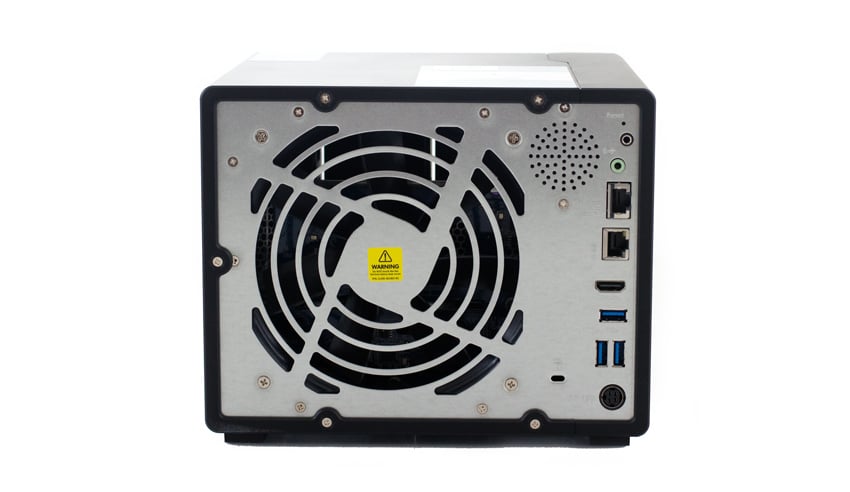
To the left of the drive bays are the Status, LAN and USB LED lights, followed by the drive LEDs below, which are labeled by the drive-bay number. At the bottom left is the Power button and USB One Touch Copy button/port.
Turning the QNAP NAS around reveals a fairly sized system fan. The rest of the TVS-951X’s connectivity resides on the right, which includes 3x USB 3.0 ports, 10GBASE-T RJ45/Gigabit Ethernet RJ45 ports, an HDMI port and the audio port. The reset button, speaker, power input and Kensington security slot are also located on the back panel.
Enterprise Synthetic Workload Analysis
Our enterprise shared storage and hard drive benchmark process preconditions each drive into steady-state with the same workload the device will be tested with under a heavy load of 16 threads with an outstanding queue of 16 per thread, and then tested in set intervals in multiple thread/queue depth profiles to show performance under light and heavy usage. Since hard drives reach their rated performance level very quickly, we only graph out the main sections of each test.
Preconditioning and Primary Steady-State Tests:
- Throughput (Read+Write IOPS Aggregate)
- Average Latency (Read+Write Latency Averaged Together)
- Max Latency (Peak Read or Write Latency)
- Latency Standard Deviation (Read+Write Standard Deviation Averaged Together)
Our Enterprise Synthetic Workload Analysis includes four profiles based on real-world tasks. These profiles have been developed to make it easier to compare to our past benchmarks as well as widely-published values such as max 4k read and write speed and 8k 70/30, which is commonly used for enterprise drives.
- 4K
- 100% Read or 100% Write
- 100% 4K
- 8K 70/30
- 70% Read, 30% Write
- 100% 8K
- 8K (Sequential)
- 100% Read or 100% Write
- 100% 8K
- 128K (Sequential)
- 100% Read or 100% Write
- 100% 128K
In the first of our enterprise workloads, we measured a long sample of random 4K performance with 100% write and 100% read activity. Measuring IOPS, the QNAP TVS-951X’s best SSD configuration was under iSCSI connectivity, which posted 37,357 IOPS read and 17,099 IOPS write. The fastest HDD configuration was with CIFS where we recorded 913 IOPS read and 325 IOPS write.
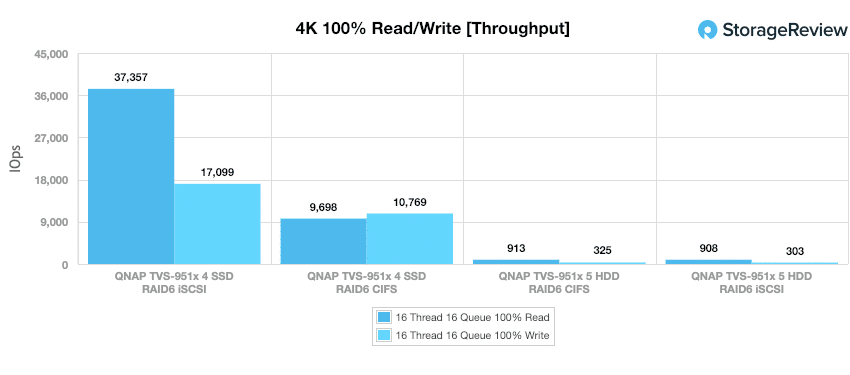
In average latency, iSCSI was showed the best SSD configuration performance with 26.4ms read and 23.8ms write while CIFS had the best HDD showing with 843.6ms write and 281.9ms read.
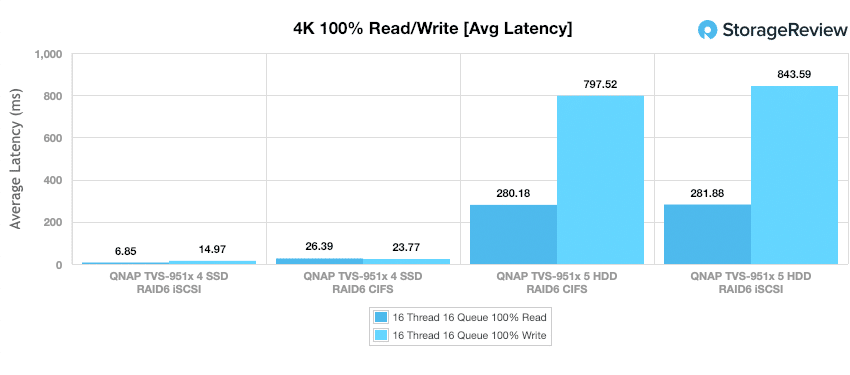
For max latency performance, the QNAP TVS-951X recorded its best SSD read under CIFS with just 70ms whereas iSCSI had the best write performance with 126.9ms. In our HDD configuration, CIFS recorded the best maximum read latency with 1,500ms, while iSCSI had the best write performance with 9,601.1ms.
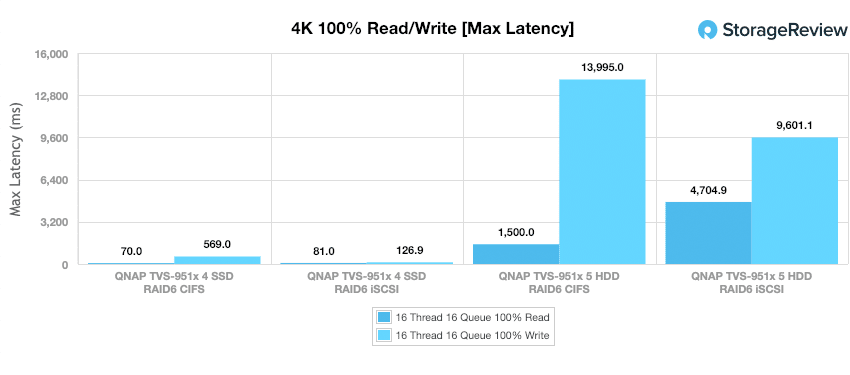
When looking at the standard deviation of random 4K performance, the TVS-951X recorded 2.9ms read and 569ms write in CIFS, while the HDD configuration reached 1,472.7ms write (iSCSI) and 145.4ms read (CIFS).
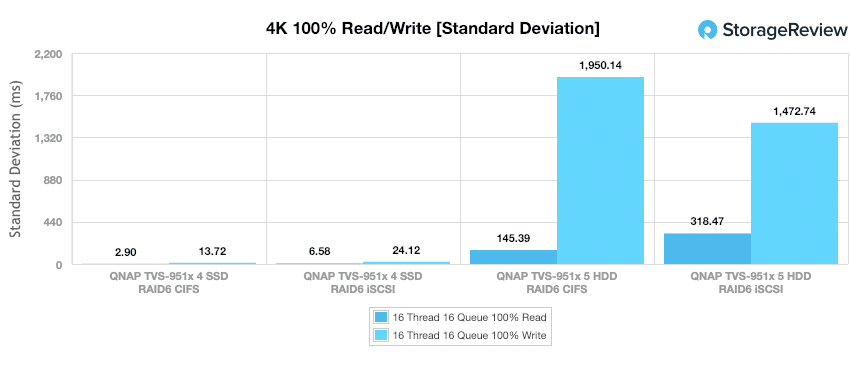
Our next benchmark measures 100% 8K sequential throughput with a 16T/16Q load in 100% read and 100% write operations. The QNAP TVS-951X recorded its best SSD read and write performance by a significant margin under iSCSI with 87,852 IOPS and 42,084 IOPS, respectively. (vs. 28,155 IOPS and 12,400 IOPS under CIFS). iSCSI connectivity showed the best HDD performance with comparable numbers to the SSD configuration (87,472 IOPS read and 41,162 IOPS write).
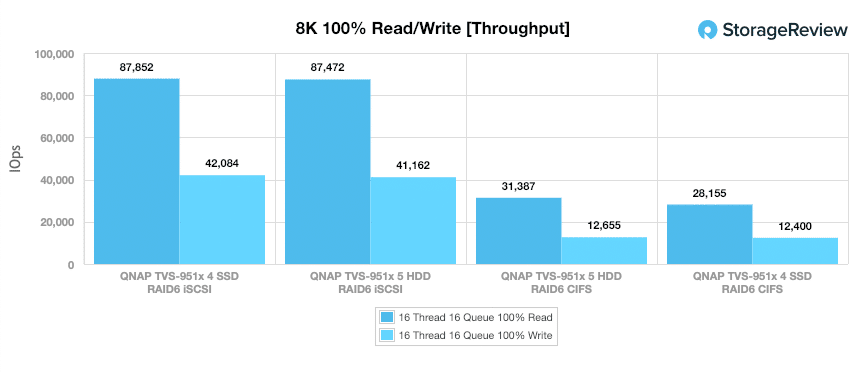
Compared to the fixed 16 thread, 16 queue max workload we performed in the 100% 4K write test, our mixed workload profiles scale the performance across a wide range of thread/queue combinations. In these tests, we span workload intensity from 2 threads and 2 queue up to 16 threads and 16 queue. In throughput, iSCSI connectivity was the best performing set up by far in our SSD configuration, posting a range of 7,215 IOPS to 21,419 IOPS. iSCSI was also the best connectivity for our HDD configuration with a range of 331 IOPS to 531 IOPS.
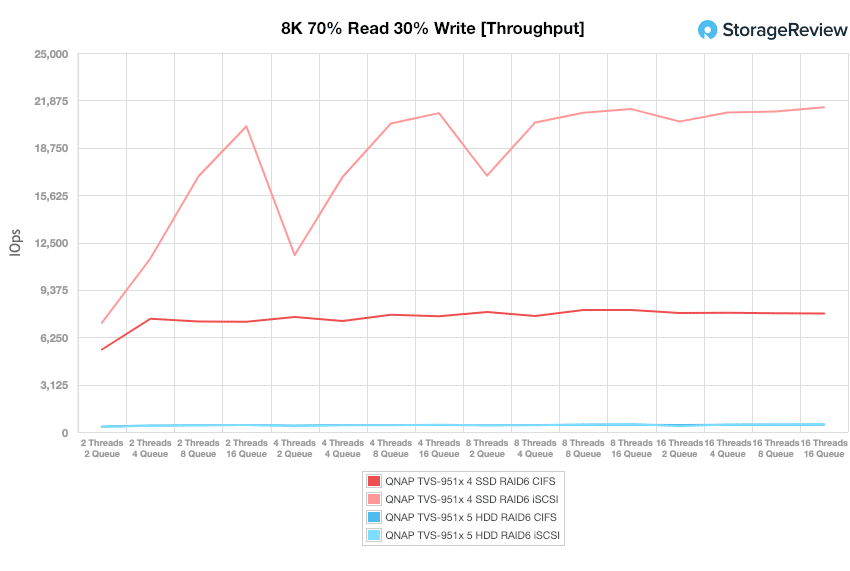
In average latency, our iSCSI SSD configuration began at just 0.55ms and finished with 11.94ms at 16T/16Q. In our HDD setup, we recorded a range of 12.03ms to 481.14ms during iSCSI connectivity.
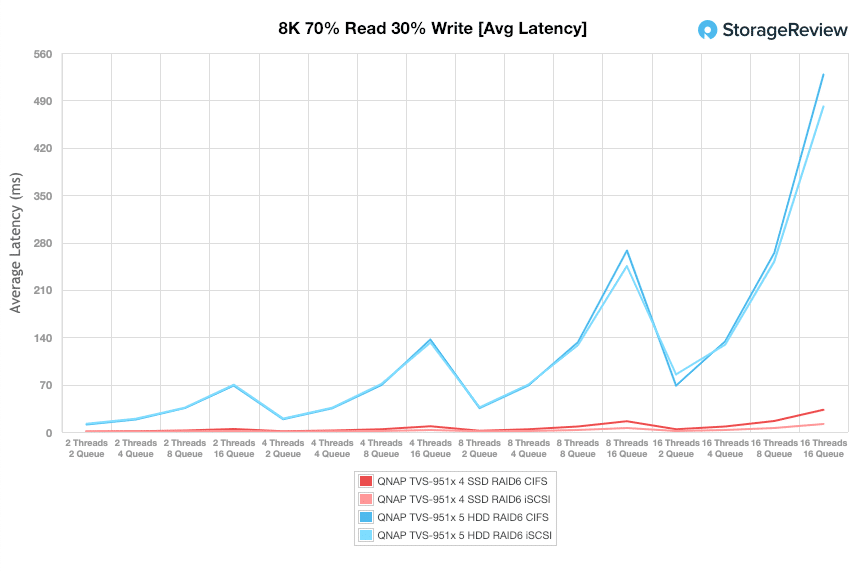
Looking at maximum latency, the QNAP TVS-951X showed top performance under iSCSI once again. For SSDs, it hit a range of 69.72ms to 145.99ms, while HDDs showed 1,351.43ms through 7,422.24ms.
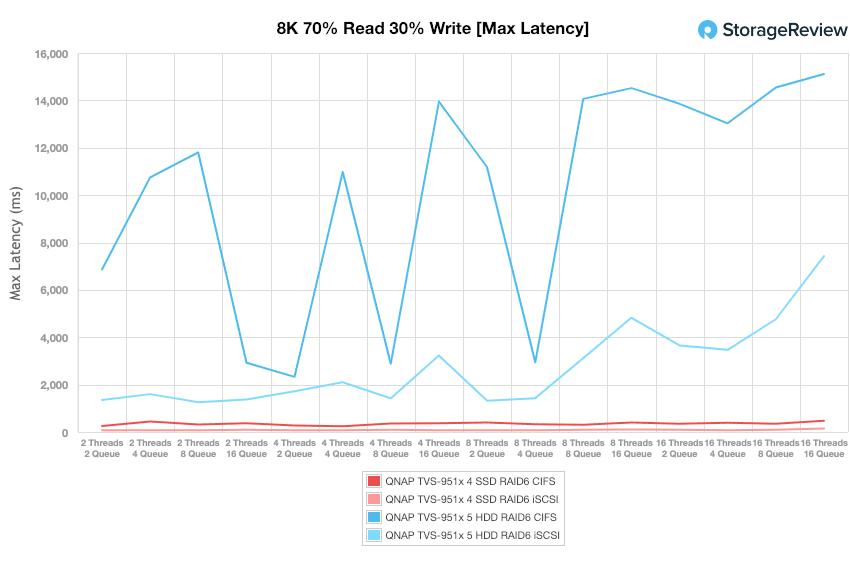
In terms of standard deviation, the QNAP TVS-951X SSD configuration recorded 1.45ms through 16.94ms under iSCSI and 1.47ms through 20.5ms under CIFS. Our HDD configuration showed a CIFS range of 96.06ms to 1,423.01ms while iSCSI had 40.16ms through 775.04ms.
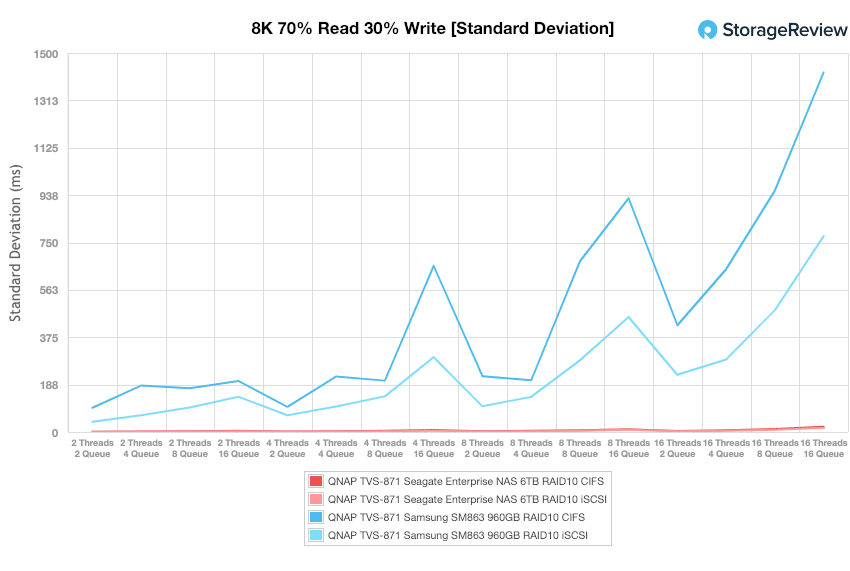
Our last test in our small NAS Synthetic Workload testing is the 128K test, which is a large block sequential test that shows the highest sequential transfer speed. When looking at the 128K performance of 100% write and 100% read activity, the QNAP TVS-951X SSD configuration showed 791MB/s read and 698MB/s write for iSCSI and 764MB/s read and 508MB/s write for CIFS. In an HDD environment, the QNAP NAS recorded 791MB/s read and 632MB/s write in ISCSI, while CIFS performance hit 790MB/s read and 505MB/s write.
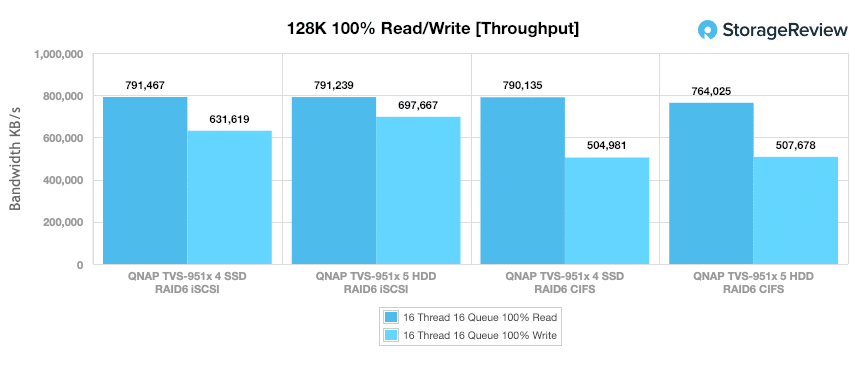
Conclusion
The TVS-951X is a solid addition to QNAP’s high-capacity, multimedia-centric NAS portfolio. This compact, 9-bay storage solution is highlighted by the power-efficient 7th-generation Intel Kaby Lake processor and its relatively inexpensive price tag. The TVS-951X is best suited as a private cloud solution due to its storage capabilities and other use cases that involve multimedia 4K transcoding/streaming including QNAP’s Cinema28 multi-zone multimedia application, Plex Media Servers and Roon Servers.
One of the nicest things about the QNAP TVS-951X is its hybrid drive bay design, as it fits five 3.5-inch drive bays and four 2.5-inch SSD slots on the front panel, all of which are fairly easy to access and manage. Users can leverage the hybrid storage support to maximize both capacity and performance through SSD caching and Qtier auto-tiering storage. It also comes equipped with built-in 10GBASE-T (10G/5G/2.5G/1G/100M) network port for some speedy transfer rates.
The TVS-951X performed quite good in our tests in our SSD configurations. In terms of throughput, the QNAP NAS recorded its best 4k performance under iSCSI connectivity, which posted 37,357 IOPS read and 17,099 IOPS write. Looking at 8k sequential throughput, The TVS-951X recorded its best read and write performance under iSCSI with 87,852 IOPS and 42,084 IOPS, respectively, which was significantly better than CIFS (28,155 IOPS and 12,400 IOPS under CIFS). During the 128k benchmark, the TVS-951X recorded 791MB/s read and 698MB/s write for iSCSI, while CIFS hit 764MB/s read and 508MB/s.
Overall, the QNAP TVS-951X is an efficient and feature-rich NAS solution that can perform most tasks needed in SMB and media content creators. The NAS comes with multiple drive options in one housing, plenty of room for capacity, and support for fast network connections.




 Amazon
Amazon